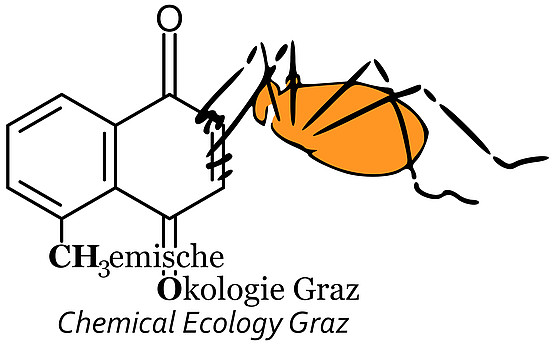FWF-Project P18486 "Chemosytematics of oribatid mites"
PI: Günther Raspotnig
Current classifications of oribatid mites (Oribatida), a suborder of mites (Acari) meanwhile comprising 10000 already described species, are artificial and a thorough revision is badly needed. However, traditional classifications of Oribatida are exclusively based on morphological characters. One character of special phylogenetic importance is represented by oil glands (syn. opisthonotal glands, glandulae lateroabdominales): The occurrence of oil glands divides the Oribatida into near-basal Palaeosomata and Enarthronota, both primitively lacking oil glands, and a vast monophyletic group of oil gland-possessing (glandulate) oribatids which include the Parhyposomata, the Mixonomata, the Desmonomata, the Brachypylida but also the Astigmata. Astigmatid mites, traditionally having been considered a distinct suborder of mites, share the synapomorphy of oil glands with glandulate Oribatida, indicating their evolution from glandulate oribatid ancestors. Thus, astigmatid mites would represent nothing more than another oribatid group.
Even though the presence of oil glands is devaluated to a symplesiomorphic character within glandulate groups, investigations into the oil gland chemistry have opened up a novel pool of phylogenetic characters. In fact, oil gland secretions are species-specifically composed, being well suited for phylogenetic analyses of both, higher and lower oribatid taxa.
So far, oil gland chemistry reflects oribatid phylogeny as follows: hydrocarbons seem to represent the basic (plesiomorphic) equipment of oil gland secretions; hydrocarbons have been found in all oil gland secretions hitherto investigated, from basal glandulate groups (such as Parhyposomata) up to Astigmata. By contrast, a set of terpenes and aromatics seems to have evolved stepwise in Mixonomata: not present yet in Parhyposomata and basic Mixonomata, it is expected to characterise all groups above (as a monophyletic unit).
Based on these preliminary (but promising) results, a chemosystematic study on a broad basis will be conducted. Therefore, a kind of comprehensive chemical “screening” of oil gland secretions of Austrian oribatids, comprising representatives of 30 superfamilies (i.e. covering the whole field of Oribatida), is planned. The resulting chemical data bank is considered a well-founded basis for a revision of oribatid systematics by novel characters: chemically homogenuous groups will be evaluated, traditionally recognised groups will be checked for their chemical homogeneity and a search for chemical synapomorphies, possibly defining novel groupings, will be conducted. Finally, the evaluation of chemosystematic characters, with respect to already known important characters from morphology, should lead to a phylogenetically founded oribatid system. Especially questions, having remained open and unanswered by morphology-based analyses (i.e. relationsips of oribatid cohorts, paraphyly of Mixonomata and Desmonomata, evolutionary origin of Astigmata and higher oribatids) are aimed to be answered on the ground of novel chemical data.
Project related publications (chronologically)
- (19) Koller, L.M., Wirth, S. & Raspotnig, G. (2012): Geranial-rich oil gland secretions: a common phenomenon in the Histiostomatidae (Acari, Astigmata)? International Journal of Acarology 38: 420-426.
- (18) Heethoff, M. & Raspotnig, G. (2012): Investigating chemical communication in oribatid and astigmatid mites – pitfalls and suggestions. Soil Organisms 84: 409-421.
- (17) Heethoff, M. & Raspotnig, G. (2012): Triggering chemical defense in an oribatid mite using artificial stimuli. Experimental and Applied Acarology 56: 287-295.
- (16) Heethoff, M. & Raspotnig, G. (2011): Expanding the “enemy-free space” for oribatid mites: evidence for chemical defense of juvenile Archegozetes longisetosus against the rove beetle Stenus juno. Experimental and Applied Acarology 56: 93-97.
- (15) Heethoff, M., Koerner, L., Norton, R.A. & Raspotnig, G. (2011): Tasty but protected – First evidence of chemical defense in oribatid mites. Journal of Chemical Ecology 37: 1037-1043
- (14) Heethoff, M. & Raspotnig, G. (2011): Is 7-hydroxyphthalide a natural compound of oil gland secretions? – Evidence from Archegozetes longisetosus (Acari, Oribatida). Acarologia 51: 229-236
- (13) Raspotnig, G., Leutgeb, V., Krisper, G. & Leis, H.J. (2011): Discrimination of Oribotritia-species by oil gland chemistry (Acari, Oribatida). Experimental and Applied Acarology 54: 211-224.
- (12) Heethoff, M., Laumann, M., Weigmann, G. & Raspotnig, G. (2011): Integrative taxonomy: Combining morphological, molecular and chemical data for delineation of the parthenogenetic Trhypochthonius tectorum complex (Acari, Oribatioda, Trhypochthoniidae). Frontiers in Zoology 8: 2.
- (11) Raspotnig, G. & Matischek, T. (2011): Anti-wetting strategies of soil-dwelling Oribatida. Acta Societatis Zoologicae Bohemicae 74: 91-96
- (10) A’Bear, A.D., Boddy, L., Raspotnig, G. & Jones, T.J. (2010): Non-grazing effects of oribatid mites on cord-forming basidiomycetes in soil microsoms. Ecological Entomology 35: 477-484.
- (9) Raspotnig, G. (2010): Oil gland secretions in Oribatida (Acari). Sabelis, M.W. & Bruin, J. (eds.): Trends in Acarology, pp. 235-239, Amsterdam.
- (8) Raspotnig, G., Stabentheiner, E., Föttinger, P., Schaider, M., Krisper, G., Rechberger, G. & Leis, H.J. (2009): Opisthonotal glands in the Camisiidae (Acari, Oribatida): Evidence for a regressive evolutionary trend. Journal of Zoological Systematics and Evolutionary Research 47: 77-87.
- (7) Raspotnig, G. & Leis, H.J. (2009): Wearing a raincoat: exocrine secretions contain anti-wetting agents in the oribatid mite, Liacarus subterraneus (Acari: Oribatida). Experimental and Applied Acarology 47: 179-190.
- (6) Raspotnig, G., Krisper, G., Fauler, G. & Leis, H.J. (2008): Distinctive cuticular hydrocarbon profiles in oribatid mites. Annales Zoologici 58 (2): 445-452.
- (5) Raspotnig, G., Kaiser, R., Stabentheiner, E. & Leis, H.J. (2008): Chrysomelidial in the opisthonotal gland secretion of the oribatid mite, Oribotritia berlesei. Journal of Chemical Ecology 34: 1081-1088.
- (4) Raspotnig, G. & Föttinger, P. (2008): Analysis of individual oil gland secretion profiles in oribatid mites (Acari: Oribatida). International Journal of Acarology 34 (4): 409-417.
- (3) Raspotnig, G., Schuster, R. & Krisper, G. (2007): A complex system for chemical communication in an oribatid mite (Acari, Oribatida). in Acarology XI: Proceedings of the 11th International Congress of Acarology, Merida, Yucatan, Mexico, pp. 185-191.
- (2) Raspotnig, G. (2006): Characterisation of monophyletic oribatid groups by oil gland chemistry – a novel systematic approach in Oribatida (Acari). Abhandlungen und Berichte des Naturkundemuseums Görlitz 78: 31-47.
- (1) Raspotnig, G. (2006): Chemical alarm and defence in the oribatid mite Collohmannia gigantea (Acari: Oribatida). Experimental and Applied Acarology 39: 177-194.

